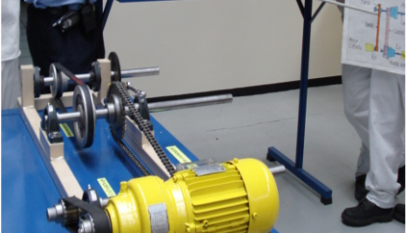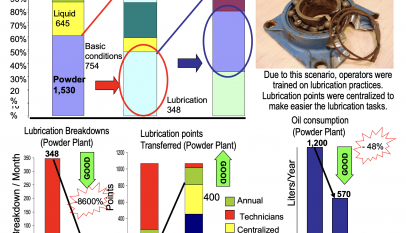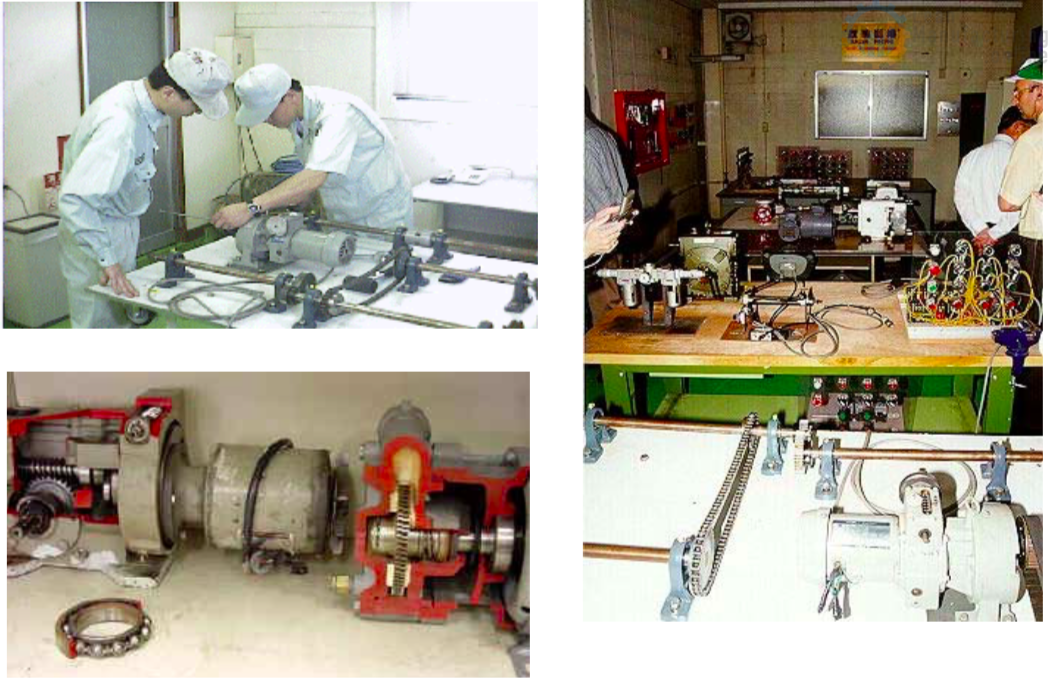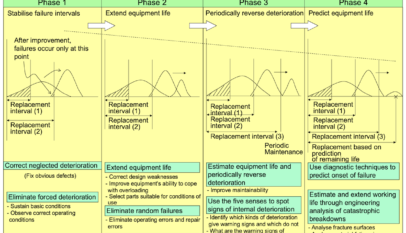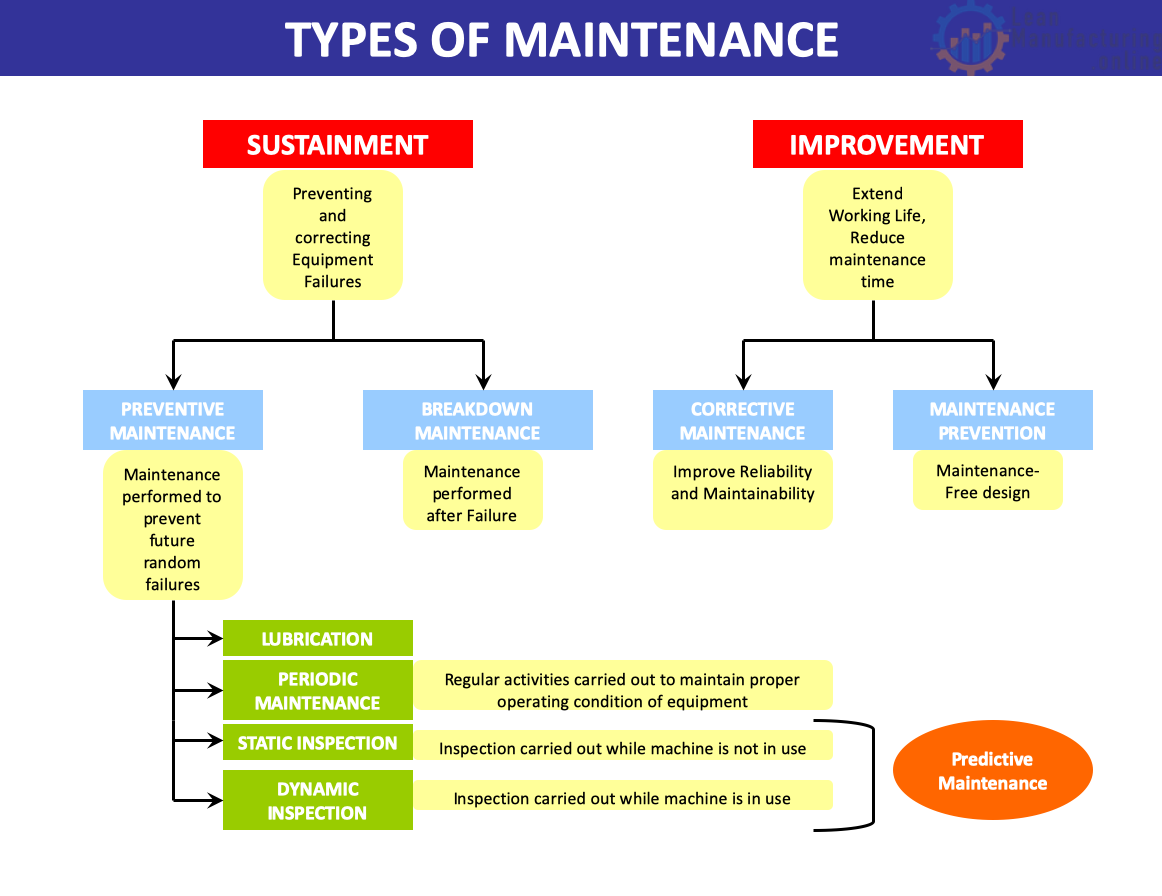The Aim of Effective (Planned) Maintenance
Effective Maintenance aims to raise the company’s productivity by lowering the total cost of its equipment over every stage, from design and fabrication to operation and maintenance (including the initial cost of the equipment itself, maintenance and other running costs, and losses due to equipment deterioration).
The goals of Effective Maintenance can be summarized as follows:

In a nutshell, Effective Maintenance aims to eliminate failures.
The Different Types of Maintenance
The two principal maintenance activities
Maintenance activities can be broadly divided into two types (see Figure “The Different Types of Maintenance”). These two types of activity need to be carried out in tandem.
- Sustainment: Preventing and correcting equipment failures.
- Improvement: Prolonging the working life of the equipment, reducing the time spent on maintenance, and eliminating the need for maintenance.
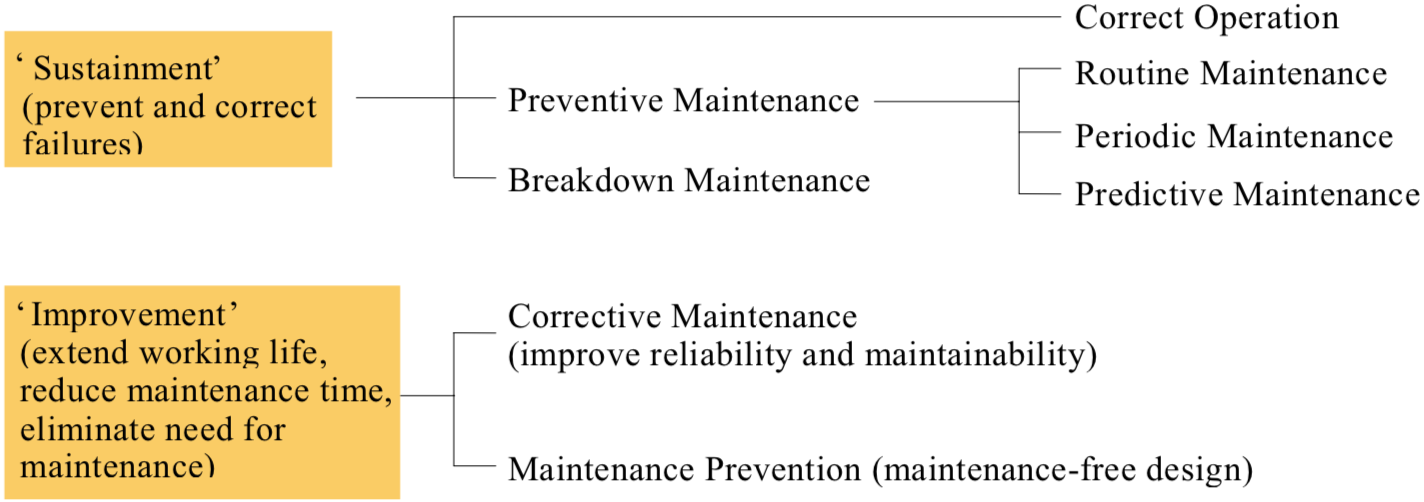
Measures for sustaining
- Correct operation
- Preventive maintenance (routine maintenance, periodic maintenance and predictive maintenance)
Measures for improving
- Corrective maintenance (improving equipment reliability and maintainability)
- Maintenance prevention (designing out the need for maintenance)
These measures can be incorporated into operators’ duties using a three-pronged approach: (1) preventing deterioration, (2) measuring deterioration, and (3) reversing deterioration. Each of the three prongs can be implemented differently, and it is not always necessary to emphasize all three equally. However, if any of the three is neglected, achieving the maintenance objective will not be possible.
Types of Effective Maintenance
The basic approaches used in Effective Maintenance are periodic, predictive, breakdown, and corrective maintenance, as described below. Each has its merits and should be used selectively to suit the situation.
(1) Periodic Maintenance
Periodic maintenance means maintaining equipment at regular intervals before any failures occur. Although it can be expensive to implement, it often turns out to be cheaper than breakdown maintenance, which consists of waiting for failures to happen and then dealing with them because the total cost of replacing components in advance is usually less than the major losses caused by a serious breakdown.
There are two types of periodic maintenance: TBM (time-based maintenance) and IR (Inspection and Repair, i.e. periodic overhaul). In TBM, the time it takes for the equipment to deteriorate to a certain level is identified, and the equipment is serviced after it has been used. In IR, however, the equipment is completely stripped down, inspected, and overhauled at fixed intervals, and any parts found below standard are repaired or replaced.
Other duties of specialist maintenance staff include routines designed to prevent forced deterioration, such as periodically checking lubricant levels; replenishing, cleaning, and replacing lubricants; cleaning the equipment, and so on.
(2) Predictive maintenance
Predictive maintenance is based on predicting the working life of key components through inspection and diagnostic testing and finding ways of ensuring that those components are used right up to the end of their working life. It makes maintenance cheaper to implement and keeps failure-related losses low. However, to permit the warning signs of problems to be spotted early, inspection and diagnostic techniques enabling the deterioration of the equipment to be predicted accurately must be developed.
One strand of predictive maintenance is CBM (condition-based maintenance), in which trends are monitored by collecting and analyzing data indicating the degree of deterioration. It requires a higher level of technology than TBM (for instance, an online monitoring system) and is more labour-intensive.
(3) Breakdown Maintenance
Breakdown maintenance consists of repairing or replacing units and parts after they have started to underperform or suffer the loss of function (i.e., after they have broken down). With some machines, this reactive approach can be more cost-effective than the proactive approach adopted in preventive maintenance. True breakdown maintenance is intentional, whereas unplanned maintenance (emergency maintenance) is unintentional and consists of repairing and replacing equipment on a “fire-fighting” basis without the pursuit of economy.
(4) Corrective Maintenance
Corrective maintenance aims to make equipment more reliable, easier to maintain, and safer to operate. Shortcomings in the existing equipment are systematically and proactively addressed by improving materials, configurations of parts, etc., to reduce deterioration and failures and thereby achieve a higher level of equipment reliability. (Essentially, the term “correction” has two meanings: in the context of breakdown maintenance, it means repairing equipment that has failed, whereas in the context of corrective maintenance, it means improving equipment so that it will not fail in the first place.)
As well as being used to improve the existing machinery, the maintenance information obtained through corrective maintenance should be incorporated into the design of next-generation equipment through the activity known as MP design (maintenance prevention design). Creating mechanisms for collating the information on MP sheets or suggestion forms and feeding it into the design process is crucial to developing a powerful, Effective Maintenance system.
(5) Other maintenance methods
One other maintenance approach is “opportunity maintenance” (or “opportunity overhaul”), which consists of using gaps in the production schedule to maintain the equipment rather than halting it specifically for the purpose.







